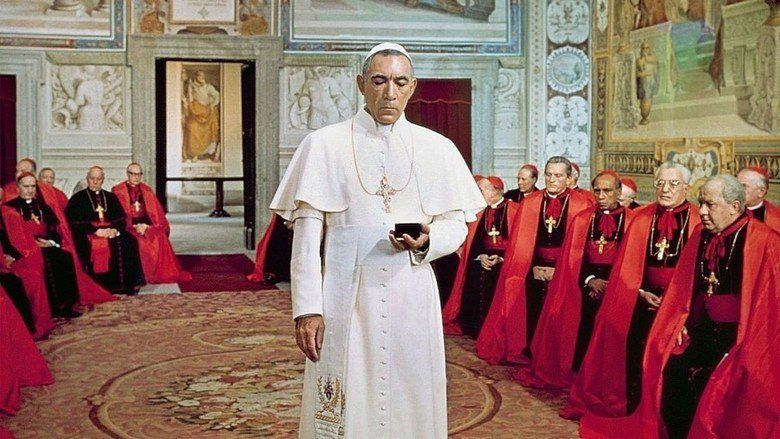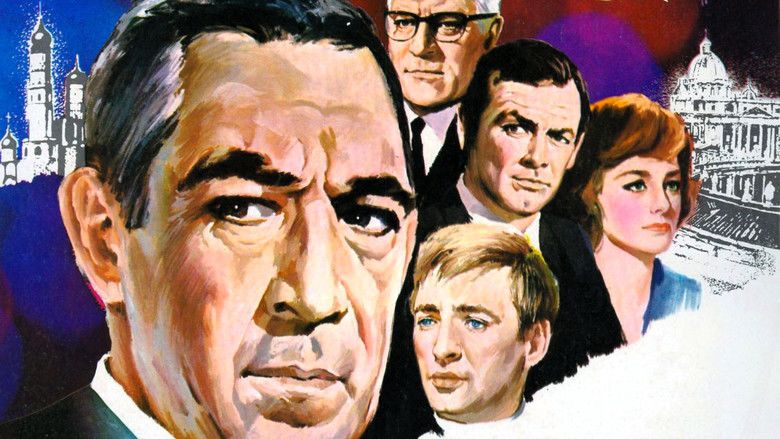The Shoes of the Fisherman
7.2 /10 1 Votes
| 7.2/10 IMDb Duration Language English | |||||||||||||||||||||||||||||||||
 | ||||||||||||||||||||||||||||||||||
Release date November 14, 1968 (1968-11-14) | ||||||||||||||||||||||||||||||||||
The shoes of the fisherman 1968
The Shoes of the Fisherman is a 1968 American drama film based on the 1963 novel of the same name by the Australian novelist Morris West. Shot in Rome, the motion picture was directed by Michael Anderson and released by Metro-Goldwyn-Mayer.
Contents
- The shoes of the fisherman 1968
- The shoes of the fisherman official trailer 1 anthony quinn movie 1968 hd
- Plot
- Cast
- Production
- Reception
- References

The shoes of the fisherman official trailer 1 anthony quinn movie 1968 hd
Plot

Set during the height of the Cold War, The Shoes of the Fisherman opens as protagonist Kiril Pavlovich Lakota (Anthony Quinn), the Metropolitan Archbishop of Lviv (or Lvov as it is spelled in the movie adaptation), is unexpectedly set free after twenty years in a Siberian labour camp by his former jailer, Piotr Ilyich Kamenev (Laurence Olivier), now the Premier of the Soviet Union.

He is sent to Rome, where the elderly fictional Pope (John Gielgud) makes him a cardinal in the title of St. Athanasius. Lakota is reluctant, begging to be given "a simple mission with simple men," but the Pope insists that he kneel and receive the scarlet zucchetto that designates the rank of Cardinal.
When the pontiff suddenly collapses and dies, the process of a papal conclave begins, and Cardinal Lakota participates as one of the electors. During the sede vacante, two cardinals in particular, Cardinal Leone (Leo McKern) and Cardinal Rinaldi (Vittorio De Sica) are shown to be papabili (candidates). After seven deadlocked ballots, Lakota is unexpectedly elected Pope as a compromise candidate (suggested by Cardinal Rinaldi) by acclamation after the cardinals, unable to decide between the leading candidates, interview him and are impressed by his ideas and his humility. Lakota takes the name of Pope Kiril. Meanwhile, the world is on the brink of nuclear war due to a Chinese–Soviet feud made worse by a famine caused by trade restrictions brought against China by the United States.
The evening after his election, Pope Kiril, with the help of his valet, Gelasio (Arnoldo Foà), sneaks out of the Vatican and explores the city of Rome dressed as a simple priest. By chance, he encounters Dr. Ruth Faber, who is in a troubled marriage with a Rome-based television journalist, George Faber (David Janssen). Later, the Pope returns to the Soviet Union, dressed in civilian clothing, to meet privately with Kamenev and Chairman Peng (Burt Kwouk) of China to discuss the ongoing crisis.
Pope Kiril realises that if the troubles in China continue, the cost could be a war that could ultimately rip the world apart. At his papal coronation, Kiril removes his tiara (in a gesture of humility) and pledges to sell the Church's property to help the Chinese, much to the delight of the crowds in St. Peter's Square below.
A major secondary plot in the film is the Pope's relationship with a controversial theologian and scientist, Father Telemond (Oskar Werner). The Pope becomes Telemond's close personal friend, but to his deep regret, in his official capacity, he must allow the Holy Office to censure Telemond for his heterodox views. To the Pope's deep grief, Father Telemond dies.
Cast
Production
Film rights were bought by MGM in 1964. They assigned it to producer George Englund who was to write the script with Morris West. (Englund was also making Dark of the Sun for the studio.)
Anthony Quinn was announced as the star of the film relatively early. The original director was to be British director Anthony Asquith, but he became ill in November 1967 (and eventually died a few months later) and was replaced by Michael Anderson.
Englund asked for technical advice from the Vatican but received no permission to film there so places like the Sistine Chapel had to be recreated.
The papal tiara used for the coronation scene in the film is modeled after Pope Paul VI's own papal tiara.
The ending of the film was changed from the book. Morris West said:
Structurally speaking I've always thought The Shoes of the Fisherman was one of my weaker books. It wanders too much. The script for the film is tighter, more direct and I think it says in a stronger way part of what I wanted to say in the novel. We've come to a point in history where men - black or white, Marxist or capitalist, christian or non christian - are going to have to make a choice. They're either going to have to commit themselves to an act of love for each other or an act of hate for each other. Men on each side have to say: "Look we're all brothers. Why do we kill each other in the streets? Don't lets drop the atomic bomb. Let's talk for one hour more." Today this is the real triumph of good over evil. It's what i've tried to put into the last speech for the film.
Reception
The film was the sixth most popular movie at the Australian box office in 1969. However it was still a notable box office flop.
Alex North was nominated for two Academy Awards for Best Score, and George Davis and Edward Carfagno for Best Art Direction.
References
The Shoes of the Fisherman WikipediaThe Shoes of the Fisherman IMDb The Shoes of the Fisherman themoviedb.org
